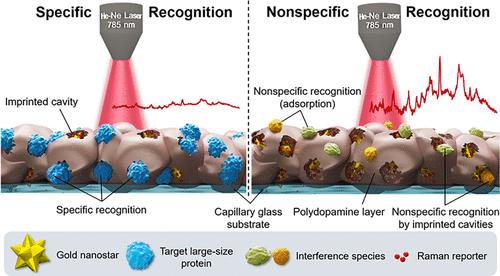当前位置:
X-MOL 学术
›
Anal. Chem.
›
论文详情
Our official English website, www.x-mol.net, welcomes your
feedback! (Note: you will need to create a separate account there.)
Molecular Imprinting-Based SERS Detection Strategy for the Large-Size Protein Quantitation and Curbing Non-Specific Recognition
Analytical Chemistry ( IF 6.7 ) Pub Date : 2024-04-12 , DOI: 10.1021/acs.analchem.4c00541 Xuan Chen 1, 2 , Abbas Ostovan 1 , Maryam Arabi 1 , Yunqing Wang 1 , Lingxin Chen 1, 3 , Jinhua Li 1, 2, 3
Analytical Chemistry ( IF 6.7 ) Pub Date : 2024-04-12 , DOI: 10.1021/acs.analchem.4c00541 Xuan Chen 1, 2 , Abbas Ostovan 1 , Maryam Arabi 1 , Yunqing Wang 1 , Lingxin Chen 1, 3 , Jinhua Li 1, 2, 3
Affiliation

|
Molecular imprinting-based surface-enhanced Raman scattering (MI-SERS) sensors have shown remarkable potential from an academic standpoint. However, their practical applications, especially in the detection of large-size protein (≥10 nm), face challenges due to the lack of versatile sensing strategies and nonspecific fouling of matrix species. Herein, we propose a Raman reporter inspector mechanism (RRIM) implemented on a protein-imprinted polydopamine (PDA) layer coated on the SERS active substrate. In the RRIM, after large-size protein recognition, the permeability of the PDA imprinted cavities undergoes changes that are scrutinized by Raman reporter molecules. Target proteins can specifically bind and fully occupy the imprinted cavities, whereas matrix species cannot. Then, Raman reporter molecules with suitable size are introduced to serve as both inspectors of the recognition status and inducers of the SERS signal, which can only penetrate through the vacant and nonspecifically filled cavities. Consequently, changes in the SERS signal exclusively originate from the specific binding of target proteins, while the nonspecific recognition of matrix species is curbed. The RRIM enables reproducible quantitation of the large-size cyanobacteria-specific protein model (≥10 nm), phycocyanin, at the level down to 2.6 × 10–3 μg L–1. Finally, the practical applicability of the RRIM is confirmed by accurately analyzing crude urban waterway samples over 21 min without any pretreatment.
中文翻译:

基于分子印迹的SERS检测策略,用于大尺寸蛋白质定量和抑制非特异性识别
从学术角度来看,基于分子印迹的表面增强拉曼散射(MI-SERS)传感器已显示出巨大的潜力。然而,由于缺乏通用的传感策略和基质物种的非特异性污染,它们的实际应用,特别是在大尺寸蛋白质(≥10 nm)的检测中,面临着挑战。在此,我们提出了一种在 SERS 活性基底上涂覆的蛋白质印迹聚多巴胺 (PDA) 层上实施的拉曼报告检查器机制 (RRIM)。在 RRIM 中,大尺寸蛋白质识别后,PDA 印迹腔的渗透性会发生变化,拉曼报告分子会对此进行检查。靶蛋白可以特异性结合并完全占据印记空腔,而基质物种则不能。然后,引入合适尺寸的拉曼报告分子,既作为识别状态的检查者,又作为SERS信号的诱导剂,只能穿透空洞和非特异性填充的空腔。因此,SERS 信号的变化完全源自靶蛋白的特异性结合,而基质物质的非特异性识别受到抑制。 RRIM 能够以低至 2.6 × 10 –3 µg L –1的水平对大尺寸蓝藻特异性蛋白质模型(≥10 nm)藻蓝蛋白进行可重复定量。最后,通过在 21 分钟内准确分析未经任何预处理的城市原始水道样品,证实了 RRIM 的实际适用性。
更新日期:2024-04-12
中文翻译:

基于分子印迹的SERS检测策略,用于大尺寸蛋白质定量和抑制非特异性识别
从学术角度来看,基于分子印迹的表面增强拉曼散射(MI-SERS)传感器已显示出巨大的潜力。然而,由于缺乏通用的传感策略和基质物种的非特异性污染,它们的实际应用,特别是在大尺寸蛋白质(≥10 nm)的检测中,面临着挑战。在此,我们提出了一种在 SERS 活性基底上涂覆的蛋白质印迹聚多巴胺 (PDA) 层上实施的拉曼报告检查器机制 (RRIM)。在 RRIM 中,大尺寸蛋白质识别后,PDA 印迹腔的渗透性会发生变化,拉曼报告分子会对此进行检查。靶蛋白可以特异性结合并完全占据印记空腔,而基质物种则不能。然后,引入合适尺寸的拉曼报告分子,既作为识别状态的检查者,又作为SERS信号的诱导剂,只能穿透空洞和非特异性填充的空腔。因此,SERS 信号的变化完全源自靶蛋白的特异性结合,而基质物质的非特异性识别受到抑制。 RRIM 能够以低至 2.6 × 10 –3 µg L –1的水平对大尺寸蓝藻特异性蛋白质模型(≥10 nm)藻蓝蛋白进行可重复定量。最后,通过在 21 分钟内准确分析未经任何预处理的城市原始水道样品,证实了 RRIM 的实际适用性。











































 京公网安备 11010802027423号
京公网安备 11010802027423号